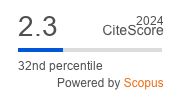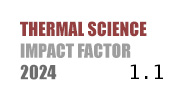THERMAL SCIENCE
International Scientific Journal
NUMERICAL INVESTIGATION OF TIME-DEPENDENT CLOUD CAVITATING FLOW AROUND A HYDROFOIL
ABSTRACT
Time-dependent cloud cavitation around the 2-D Clark-Y hydrofoil was investigated in this paper based on an improved filter based model and a density correction method. The filter-scale in filter based model simulation was discussed and validated according to the grid size. Numerical results show that in the transition from sheet cavitation to cloud cavitation, the sheet cavity grows slowly to the maximum length during the re-entrant jet develops. The mild shedding bubble cluster convects downwards the hydrofoil and continues to grow up after detaching from the suction surface of hydrofoil, and a bubble cluster introduced at the rear part of hydrofoil. While the sheet cavity generates, the bubble cluster breakups.
KEYWORDS
PAPER SUBMITTED: 2015-09-03
PAPER REVISED: 2016-01-02
PAPER ACCEPTED: 2016-01-28
PUBLISHED ONLINE: 2016-08-13
THERMAL SCIENCE YEAR
2016, VOLUME
20, ISSUE
Issue 3, PAGES [913 - 920]
- Arndt, R. E., Cavitation Research from an International Perspective, Proceedings, IOP Conference Series: Earth and Environmental Science, IOP Publishing, Beijing, 2012, Vol. 15, Part 1, 012002
- Arndt, R. E., Some Remarks on Hydrofoil Cavitation, Journal of Hydrodynamics, Ser. B, 24 (2012), 3, pp. 305-314
- Brennen, C. E., Cavitation and Bubble Dynamics, Cambridge University Press, Cambridge, UK, 2013
- Brennen, C. E., Hydrodynamics of Pumps, Cambridge University Press, Cambridge, UK, 2011
- Coutier-Delgosha, O., et al., Legoupil, Analysis of Cavitating Flow Structure by Experimental and Numerical Investigations, Journal of Fluid Mechanics, 578 (2007), May, pp. 171-222
- Coutier-Delgosha, O., et al., Numerical Simulation of the Unsteady Behaviour of Cavitating Flows, International Journal for Numerical Methods in Fluids, 42 (2003), 5, pp. 527-548
- Senocak, I., Shyy, W., Evaluations of Cavitation Models for Navier-Stokes Computations, Proceedings, ASME 2002 Joint US-European Fluids Engineering Division Conference, American Society of Mechanical Engineers, Montreal, Que., Canada, 2002, Vol. 1, pp. 395-401
- Gopalan, S., Katz, J., Flow Structure and Modeling Issues in the Closure Region of Attached Cavitation, Physics of Fluids, 12 (2000), 4, pp. 895-911
- Kunz, R. F., et al., A Preconditioned Navier-Stokes Method for Two-Phase Flows with Application to Cavitation Prediction, Computers & Fluids, 29 (2000), 8, pp. 849-875
- Singhal, A. K., et al., Mathematical Basis and Validation of the Full Cavitation Model, Journal of Fluids Engineering, 124 (2002), 3, pp. 617-624
- Zwart, P. J., et al., A Two-Phase Flow Model for Predicting Cavitation Dynamics, Proceedings, 5th International Conference on Multiphase Flow, Yokohama, Japan, 2004
- Schnerr, G., Sauer, J., Physical and Numerical Modeling of Unsteady Cavitation Dynamics, Proceedings, 4th International Conference on Multiphase Flow, New Orleans, La., USA, 2001
- Morgut, M., Nobile, E., Numerical Predictions of Cavitating Flow around Model Scale Propellers by CFD and Advanced Model Calibration, International Journal of Rotating Machinery, 2012 (2012), ID618180, p. 11
- Wang, G., et al., Dynamics of Attached Turbulent Cavitating Flows, Progress in Aerospace Sciences, 37 (2001), 6, pp. 551-581

